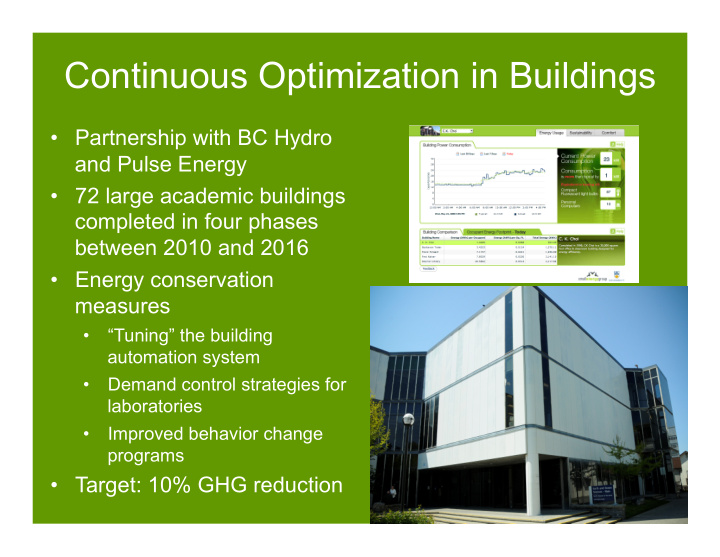



Continuous Optimization in Buildings • Partnership with BC Hydro and Pulse Energy • 72 large academic buildings completed in four phases between 2010 and 2016 • Energy conservation measures • “Tuning” the building automation system • Demand control strategies for laboratories • Improved behavior change programs • Target: 10% GHG reduction
UBC Bioenergy Research & Demonstration Facility Four story CLT building Heating mode: 6 MW Cogen mode : 2 MW(elec) + 3 MW(heat) CO2 Reduc’n: 4,000 tpy of GHG
Steam to Hot Water Conversion • One of largest Hot Water conversion in North America - $80-90M • 24% Energy and 22% GHG savings • Replaces aging infrastructure with high operational and deferred maintenance costs • Increases fuel source flexibility • 14 km of pre-insulated EN 253 hot water distribution piping • 131 Energy transfer stations in building mechanical rooms
Integrated Campus Systems –Energy, Water, Waste
Regenerative Sustainability Gradient Sustainability Rating Project G Project F CIRS Project E UBC Academic Project D and Community Project C Projects Project B LEED Project A Gold Time Steam to Hot UBC Space use efficiency Water “Foundational” BR&DP Distributed Peaking Continuous Waste Heat Recovery Projects Optimization (Sinks and Sources) Smart Energy Systems Integration (Energy Demand and Energy Use Reductions; PEDM; Renewables)
UTown@UBC • From ¡commuter ¡ campus ¡to ¡sustainable ¡ community ¡ • More ¡affordable ¡ housing ¡for ¡students ¡& ¡ families ¡to ¡live ¡on ¡ campus ¡ • Enhance ¡academic ¡ engagement, ¡campus ¡ life ¡and ¡the ¡ environment ¡
Sustainable Community Indicators 4.5 4.0 3.5 3.0 2.5 2.0 1.5 1.0 0.5 0.0 1997 2011 Transit trips Vehicle trips Parking spaces Residents Daytime population
Utown Build-out 2001 Population: ~ 10,000 • 7,000 Students • 700 Faculty/ Staff Rental • 1,700 Family 2010 Population: ~16,500 • 8,500 Students • 1,900 Faculty/ Staff Rental • 6,000 Family/ Co-Development (2,100 are affiliated) 2025 Population: ~ 30,000 • 14,000 Students • 3,300 Faculty/Staff Rental • 12,800 Family Housing/Co-Development (4,750 are affiliated)
Social Sustainability | Family Housing About ¡10% ¡of ¡our ¡full-‑ • Bme ¡faculty ¡and ¡staff ¡ now ¡live ¡on ¡campus, ¡ occupying ¡half ¡of ¡the ¡ 2,200 ¡apartments ¡and ¡ townhouses ¡that ¡were ¡ built ¡as ¡of ¡2008 ¡ ¡ ¡ 50% ¡of ¡all ¡new ¡family ¡ • homes ¡in ¡UTown@UBC ¡ will ¡have ¡at ¡least ¡one ¡ member ¡of ¡the ¡ household ¡who ¡works ¡or ¡ studies ¡on ¡campus ¡
Social Sustainability | Family Housing 20% ¡of ¡all ¡new ¡apartments ¡ • and ¡townhouses ¡on ¡campus ¡ are ¡rental, ¡and ¡half ¡of ¡these ¡ units ¡are ¡available ¡at ¡below-‑ market ¡rates ¡ About ¡20% ¡off ¡ • comparable ¡rentals ¡in ¡ adjacent ¡Vancouver ¡areas ¡ Co-‑development ¡opportuniBes ¡ • save ¡UBC ¡faculty ¡and ¡staff ¡up ¡ to ¡20% ¡off ¡market ¡prices ¡by ¡ reducing ¡typical ¡project ¡ management ¡and ¡promoBonal ¡ costs ¡
UBC Farm � Mission To be a global leader in the creation of new patterns for sustainable and healthy communities integrated with their surrounding ecology
2011 User Engagement and Trends: 55,000+ Site Visits � Partners � Projects � 8 Faculties � 150+ Projects 37 UBC Departments � 50 UBC Courses 100+ Partners � 2,400+ UBC Students � Student"and"Credit"Course"Involvement"at"UBC"Farm" UBC$Farm$Gross$Farm$Product$Sales$ $180,000%% 3500# 90# 82# $160,000%% 80# $160,000%% 3000# 66# $140,000%% 70# $125,000%% 2500# $114,000%% 60# $120,000%% #"of"credit"courses" 51# #"of"students" 2000# $100,000%% 50# 43# $85,000%% Students# 41# $78,000%% 36# $80,000%% 40# Credit#Courses# 1500# 2904# $65,000%% 30# 30# $55,000%% 2552# 2400# $60,000%% 30# 2250# 2211# 2100# 1000# $40,000%% 20# 14# $30,000%% $30,000%% 1150# 500# 7# $20,000%% 800# 10# 4# $8,000%% $10,000%% 350# 200# 240# $0%% 0# 0# 2001% 2002% 2003% 2004% 2005% 2006% 2007% 2008% 2009% 2010% 2011% 2001# 2002# 2003# 2004# 2005# 2006# 2007# 2008# 2009# 2010# 2011#
Agent of Change
The Role of the University as Agent of Change “New forms of partnership between the private, public and NGO sectors should be a critical component of the sustainability agenda . . . identify and flesh out new, more integrated models of interaction . . . transform the institutional rules and processes that govern the universities’ relationships with the outside world.” (Stephen Toope, Submission to Secretary-General’s Global Colloquium of University Presidents, New York University, Nov 28-29, 2007)
Strategic Alliance Partnerships Energy systems, decision support Smart energy system Clean energy Utown@UBC as living lab Residential sustainability Energy, engagement, mobility
Sustainability Pathways Year 1 Year 2 Year 3 Year 4 2 3 4 1 2 4 1 3 3 2 4 Beyond the Sustainability-oriented student immersive classroom SUST 101: experience outside the university, locally or globally Introduction to Leadership sustainability course: Students ideas and explore & reflect 1 2 principals, models on attainment of Discipline- and contemporary sustainability Courses within an existing program leading to based issues. The an understanding of ones discipline through a attributes during sustainability lens. course could their learning contain a pathway. component Opportunity for 2 3 mentored or led mentoring Courses ¡based ¡on ¡a ¡theme ¡such ¡as ¡ “ water ” ¡ ¡ Theme- by a senior taken ¡inside ¡or ¡outside ¡the ¡student ’ s ¡program ¡of ¡ undergraduates. based study. ¡Ideally ¡would ¡include ¡some ¡case ¡study ¡ students. analysis ¡of ¡the ¡themaBc ¡issue. ¡ Holistic Systems Acting for Positive Sustainability Awareness & 1 2 3 4 Thinking Knowledge Integration Change
Recommend
More recommend